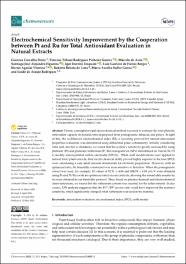Electrochemical Sensitivity Improvement by the Cooperation between Pt and Ru for Total Antioxidant Evaluation in Natural Extracts

Ver/
Descargar
(application/pdf: 2.682Mb)
(application/pdf: 2.682Mb)
Fecha
2023-04-23Autor(es)
Carvalho Diniz, Gustavo
Pinheiro Gome, Vinicius Tribuzi Rodrigues
De Assis, Marcelo
Santiago José, Alejandro Figueroa
Ferreira Torquato, Igor
De Freitas Borges, Luiz Gustavo
Aguilar Vitorino, Hector
Batista de Lima, Roberto
Suller Garcia, Marco Aurélio
De Araujo Rodrigues, Isaíde
Metadatos
Mostrar el registro completo del ítemResumen
“Herein, a straightforward electrochemical method was used to evaluate the total phenolic
antioxidant capacity in natural extracts prepared from pomegranate, hibiscus, and pitaya. In light
of this, the well-known electrochemical index (EI), a screening protocol for natural antioxidant
properties evaluation, was determined using differential pulse voltammetry. Initially considering
rutin and catechin as standards, we found that the system’s sensitivity greatly increased by using
platinum (Pt) and platinum/ruthenium (Pt/Ru) nanoparticles (NPs) immobilized on Vulcan XC-72
to modify screen-printed carbon electrodes (SPCEs). When such modifications were applied to
natural fruit/plant extracts, their electrochemical ability proved highly superior to the bare SPCE,
even considering a very small amount of materials for electrode preparation. However, with an
optimized ratio, the bimetallic counterpart was more sensitive to detection. When the pomegranate
extract was used, for example, EI values of 52.51 ± 6.00 and 104.79 ± 6.89 µA/V were obtained
using Pt and Pt/Ru (with an optimized ratio) electrocatalysts, showing the remarkable sensitivity
increase obtained in our bimetallic protocol. Thus, based on physicochemical and electrochemical
characterizations, we found that the ruthenium content was essential for the achievements. In due
course, XPS analysis suggested that the Pt2+/Pt0
species ratio could have improved the system’s
sensitivity, which significantly changed when ruthenium was used in the material.
“
Colecciones
- SCOPUS [380]

